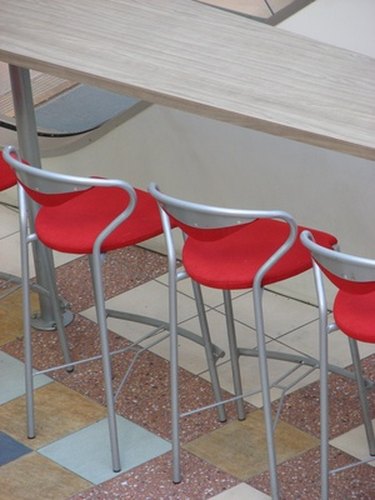Things You'll Need
Tape measure
Pencil
Graph paper with 1/4-inch squares.

A breakfast bar can add an extra place for family gatherings, socialization and food preparation to your kitchen. Breakfast bars are usually attached to standard height counters, adding usability to the back of a counter separating a kitchen from another room, or making your kitchen island a gathering place for casual dining. When the breakfast bar isn't used for dining, it can be a homework space for kids and teens or an extended space for food preparation. When entertaining guests buffet-style, lay out the food on the breakfast bar for convenient serving that keeps the table areas clear.
Step 1
Measure your kitchen with a tape measure to determine how much space you have for your breakfast bar. If you're adding a countertop in an already small space, remember that you'll want at least three feet of clear distance between the backs of the breakfast bar chairs and any other furniture or walls. Determine from these measurements how wide and deep your breakfast bar will be.
Video of the Day
Step 2
Look at the other countertops in your kitchen. If the corners are angled, your breakfast bar's corners should be angled. If the other corners are square or rounded, the bar should match that as well.
Step 3
Draw out the shape of your breakfast bar on graph paper, using one square to equal 1 inch of your countertop. This creates a drawing in one-quarter scale. If this is too large for your graph paper, use one square per 2 inches, or one-eighth scale.
Step 4
Determine the height of your breakfast bar. Standard height for a bar countertop is 42 inches from the floor, which makes finding the proper height stools easier. If you want a higher or lower countertop, make sure you can find suitable seating; you may need adjustable stools in this case.
Step 5
Select your method of attaching the breakfast bar to your existing counter. For a small bar, you may be able to support it with a triangular brace at each end, leaving open space between the standard counter height and the breakfast bar's bottom. Alternatively, you may want the bar attached all along the back of the existing counter, which means you will need to consider the decor for the rise between counter heights.
Step 6
Draw a front view of both the breakfast bar and the counter to which you're attaching it on a fresh sheet of graph paper. Use the same scale (one square per 1 or 2 inches) that you used on your first drawing. Include the front edge thickness of the breakfast bar top, the counter width and height, and a frontal view of the method you are using to attach the bar to the countertop.
Step 7
Select your countertop finish. Matching your existing countertops will make your kitchen look more cohesive, but if you don't want to do that, choose something that will complement your existing countertops or other decor. For example, if you have tile countertops but an oak kitchen table, an oak breakfast bar that has the same shaping and finish as the table will tie the kitchen together. If you have laminate countertops and want a classier breakfast bar--such as a granite finish--add other matching elements of granite to your kitchen, such as countertop utensil holders, decorative plant pots, cutting boards or small storage or end tables.
Step 8
Note your finish choices on your drawings and discuss them with the person who will be building your breakfast bar until you are satisfied with the look and the builder is satisfied with the structure.
Video of the Day